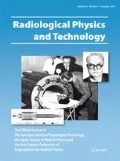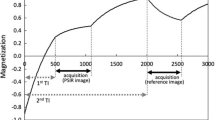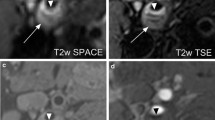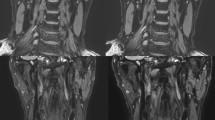Abstract
Magnetic resonance imaging (MRI) is widely used to detect carotid atherosclerotic plaques. Although it is important to evaluate vulnerable carotid plaques containing lipids and intra-plaque hemorrhages (IPHs) using T1-weighted images, the image contrast changes depending on the imaging settings. Moreover, to distinguish between a thrombus and a hemorrhage, it is useful to evaluate the iron content of the plaque using both T1-weighted and T2*-weighted images. Therefore, a quantitative evaluation of carotid atherosclerotic plaques using T1 and T2* values may be necessary for the accurate evaluation of plaque components. The purpose of this study was to determine whether the multi-echo phase-sensitive inversion recovery (mPSIR) sequence can improve T1 contrast while simultaneously providing accurate T1 and T2* values of an IPH. T1 and T2* values measured using mPSIR were compared to values from conventional methods in phantom and in vivo studies. In the phantom study, the T1 and T2* values estimated using mPSIR were linearly correlated with those of conventional methods. In the in vivo study, mPSIR demonstrated higher T1 contrast between the IPH phantom and sternocleidomastoid muscle than the conventional method. Moreover, the T1 and T2* values of the blood vessel wall and sternocleidomastoid muscle estimated using mPSIR were correlated with values measured by conventional methods and with values reported previously. The mPSIR sequence improved T1 contrast while simultaneously providing accurate T1 and T2* values of the neck region. Although further study is required to evaluate the clinical utility, mPSIR may improve carotid atherosclerotic plaque detection and provide detailed information about plaque components.





Similar content being viewed by others
References
Stary HC, Chandler AB, Dinsmore RE, Fuster V, Glagov S, Insull W, et al. A definition of advanced types of atherosclerotic lesions and a histological classification of atherosclerosis. A report from the Committee on Vascular Lesions of the Council on Arteriosclerosis, American Heart Association. Circulation. 1995;92:1355–74.
Stary HC, Chandler AB, Glagov S, Guyton JR, Insull W, Rosenfeld ME, et al. A definition of initial, fatty streak, and intermediate lesions of atherosclerosis. A report from the Committee on Vascular Lesions of the Council on Arteriosclerosis, American Heart Association. Arterioscler Thromb. 1994;14:840–56.
Cai JM. Classification of Human Carotid Atherosclerotic Lesions With In Vivo Multicontrast Magnetic Resonance Imaging. Circulation. 2002;106:1368–73.
Saam T, Hatsukami TS, Takaya N, Chu B, Underhill H, Kerwin WS, et al. The vulnerable, or high-risk, atherosclerotic plaque: noninvasive MR imaging for characterization and assessment. Radiology. 2007;244:64–77.
Takaya N, Yuan C, Chu B, Saam T, Polissar NL, Jarvik GP, et al. Presence of intraplaque hemorrhage stimulates progression of carotid atherosclerotic plaques: a high-resolution magnetic resonance imaging study. Circulation. 2005;111:2768–75.
Yuan C, Mitsumori LM, Beach KW, Maravilla KR. Carotid atherosclerotic plaque: noninvasive MR characterization and identification of vulnerable lesions. Radiology. 2001;221:285–99.
Yamada N, Higashi M, Otsubo R, Sakuma T, Oyama N, Tanaka R, et al. Association between signal hyperintensity on T1-weighted MR imaging of carotid plaques and ipsilateral ischemic events. Am J Neuroradiol. 2007;28:287–92.
Watanabe Y, Nagayama M. MR plaque imaging of the carotid artery. Neuroradiology. 2010;52:253–74.
Moody AR, Murphy RE, Morgan PS, Martel AL, Delay GS, Allder S, et al. Characterization of complicated carotid plaque with magnetic resonance direct thrombus imaging in patients with cerebral ischemia. Circulation. 2003;107:3047–52.
Sato Y, Ogasawara K, Narumi S, Sasaki M, Saito A, Tsushima E, et al. Optimal MR plaque imaging for cervical carotid artery stenosis in predicting the development of microembolic signals during exposure of carotid arteries in endarterectomy: comparison of 4 T1-weighted imaging techniques. Am J Neuroradiol. 2016;37:1146–54.
Chu B. Hemorrhage in the atherosclerotic carotid plaque: a high-resolution MRI study. Stroke. 2004;35:1079–84.
Zhu DC, Vu AT, Ota H, DeMarco JK. An optimized 3D spoiled gradient recalled echo pulse sequence for hemorrhage assessment using inversion recovery and multiple echoes (3D SHINE) for carotid plaque imaging. Magn Reson Med. 2010;64:1341–51.
Kellman P, Arai AE, McVeigh ER, Aletras AH. Phase-sensitive inversion recovery for detecting myocardial infarction using gadolinium-delayed hyperenhancement. Magn Reson Med. 2002;47:372–83.
Qi H, Sun J, Qiao H, Chen S, Zhou Z, Pan X, et al. Carotid intraplaque hemorrhage imaging with quantitative vessel wall T1 mapping: technical development and initial experience. Radiology. 2017;170526–9. https://doi.org/10.1148/radiol.2017170526.
Wang J, Börnert P, Zhao H, Hippe DS, Zhao X, Balu N, et al. Simultaneous noncontrast angiography and intraPlaque hemorrhage (SNAP) imaging for carotid atherosclerotic disease evaluation. Magn Reson Med. 2013;69:337–45.
Wang J, Ferguson MS, Balu N, Yuan C, Hatsukami TS, Börnert P. Improved carotid intraplaque hemorrhage imaging using a slab-selective phase-sensitive inversion-recovery (SPI) sequence. Magn Reson Med. 2010;64:1332–40.
Zhu DC, Ferguson MS, DeMarco JK. An optimized 3D inversion recovery prepared fast spoiled gradient recalled sequence for carotid plaque hemorrhage imaging at 3.0 T. Magn Reson Imaging. 2008;26:1360–6.
Warntjes MJ, Kihlberg J, Engvall J. Rapid T1 quantification based on 3D phase sensitive inversion recovery. BMC Med Imaging. 2010;10:19.
Fujiwara Y, Maruyama H, Kosaka N, Ishimori Y. Simultaneous acquisition of high-contrast and quantitative liver T 1 images using 3D phase-sensitive inversion recovery: a feasibility study. Acta Radiol. 2016;58:899–905.
Coolen BF, Poot DHJ, Liem MI, Smits LP, Gao S, Kotek G, et al. Three-dimensional quantitative T1 and T2 mapping of the carotid artery: sequence design and in vivo feasibility. Magn Reson Med. 2015;75:1008–17.
Narumi S, Sasaki M, Ohba H, Ogasawara K, Kobayashi M, Hitomi J, et al. Prediction of carotid plaque characteristics using non-gated MR imaging: correlation with endarterectomy specimens. Am J Neuroradiol. 2013;34:191–7.
Yamada K, Yoshimura S, Kawasaki M, Enomoto Y, Asano T, Hara A, et al. Embolic complications after carotid artery stenting or carotid endarterectomy are associated with tissue characteristics of carotid plaques evaluated by magnetic resonance imaging. Atherosclerosis. 2011;215:399–404.
Yoshida K, Narumi O, Chin M, Inoue K, Tabuchi T, Oda K, et al. Characterization of carotid atherosclerosis and detection of soft plaque with use of black-blood MR imaging. AJNR Am J Neuroradiol. Am J Neuroradiol. 2008;29:868–74.
Takemoto K, Ueba T, Takano K, Abe H, Hirata Y, Higashi T, et al. Quantitative evaluation using the plaque/muscle ratio index panels predicts plaque type and risk of embolism in patients undergoing carotid artery stenting. Clin Neurol Neurosurg. 2013;115:1298–303.
Saam T, Cai J, Ma L, Cai Y-Q, Ferguson MS, Polissar NL, et al. Comparison of symptomatic and asymptomatic atherosclerotic carotid plaque features with in vivo MR imaging. Radiology. 2006;240:464–72.
Bernstein MA, King KF, Zhou XJ. Handbook of MRI pulse sequences. London: Elsevier; 2004.
Saito A, Sasaki M, Ogasawara K, Kobayashi M, Hitomi J, Narumi S, et al. Carotid plaque signal differences among four kinds of T1-weighted magnetic resonance imaging techniques: a histopathological correlation study. Neuroradiology. 2012;54:1187–94.
Sharkey-Toppen TP, Mihai G, Maiseyeu A, Tran T, Clymer BD, Simonetti OP, et al. Improved in vivo human carotid artery wall T 2* estimation. Magn Reson Imaging. 2013;31:44–52.
Author information
Authors and Affiliations
Corresponding author
Ethics declarations
Conflict of interest
This study was supported in part by a research grant from the Policy-Based Medical Services Foundation.
Statement of human rights
All procedures performed in studies involving human participants were conducted in accordance with the ethical standards of an institutional and/or national research committee and with the 1964 Declaration of Helsinki and its later amendments, or with comparable ethical standards.
Informed consent
Informed consent was obtained from each participant included in this study.
About this article
Cite this article
Fujiwara, Y., Maruyama, H., Toyomaru, K. et al. Quantitative T1 and T2* carotid atherosclerotic plaque imaging using a three-dimensional multi-echo phase-sensitive inversion recovery sequence: a feasibility study. Radiol Phys Technol 11, 156–164 (2018). https://doi.org/10.1007/s12194-018-0449-2
Received:
Revised:
Accepted:
Published:
Issue Date:
DOI: https://doi.org/10.1007/s12194-018-0449-2




